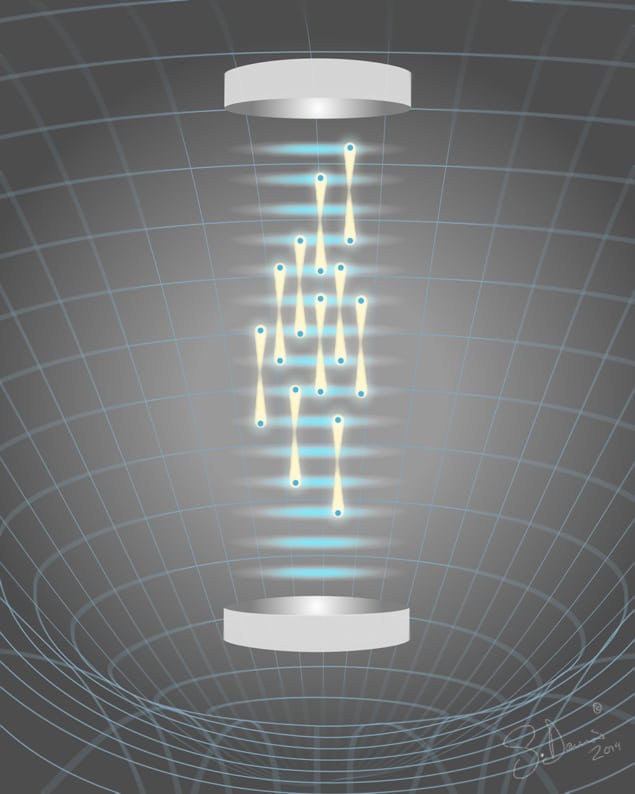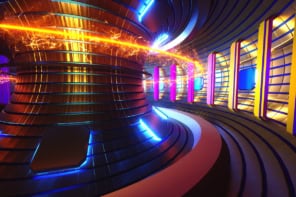
Atoms held in place by laser beams offer a new and more compact means of measuring the local acceleration due to gravity, paving the way for applications ranging from geophysical exploration to sensitive tests of fundamental forces.
The new device, which was developed by Victoria Xu and colleagues at the University of California, Berkeley, US, exploits the quantum properties of cold, trapped atoms to measure tiny variations in the Earth’s gravitational field. Like other such “quantum gravimeters”, it relies on the interference pattern generated when clouds of atoms, or matter waves, are first vertically separated in space, and then allowed to recombine. Because the gravitational acceleration g depends on altitude above the Earth’s surface (as well as factors such as the local density of the Earth’s crust, and the presence of massive objects nearby) the two groups of atoms experience slightly different gravitational potential energies. This difference translates into a phase shift that can be detected in the laboratory.
Suspended in space
The twist is that whereas most gravimeters measure the effects of gravity on atoms as they fall through space, the Berkeley device instead uses atoms that are suspended in an optical trap. This makes it possible for the atoms to interact with the gravitational field for up to 20 seconds, improving the sensitivity of the measurement. “The longer you can allow that phase difference between the two arms of the interferometer to accumulate, the smaller the effect you can measure at the end,” Xu explains. As a result, the team is easily able to measure potential energy differences that arise when atoms are separated by as little as a few microns.

The researchers begin their gravitational measurements by cooling a sample of caesium atoms to 300 nK and launching them upward within a vacuum chamber. Next, they apply a sequence of two pulses of light, set to a frequency and intensity that places the atoms in a quantum superposition of two spatially separated states. At the apex of their trajectory, the atoms are caught in an optical lattice formed by a beam of laser light passing between a pair of highly reflective mirrors. The atoms remain trapped for up to 20 s, at which point the researchers turn off the lattice, allow the atoms to fall, and apply a second pair of light pulses to recombine and interfere the atomic wave packets. The resulting phase difference is proportional to the difference in gravitational potential energy the atoms experienced during their time in the trap.
In addition to its long interaction times, the Berkeley gravimeter has two other advantages over devices based on free-falling atoms. The first is that its geometry makes it far less sensitive to noise caused by vibrations in the laboratory. The second is that it is relatively compact. The team’s entire experimental set-up fits onto an optical bench measuring 1.2 m by 2.4 m, and the atoms themselves move only a few millimetres. An equivalent experiment performed on atoms in free fall would, the researchers note, require a vacuum system half a kilometre tall.
Novel geometry, novel experiments
Xu says that their gravimeter could be used to measure the gravitational potential of small objects. “If you work in a free-fall geometry, this is a pretty hard measurement to do, because you’re just dropping atoms past the signal you’re interested in,” she says. With trapped atoms, in contrast, the atoms can be held in the area where the gradient of the gravitational potential is greatest. This, she says, should make it possible to perform more sensitive measurements of short-range forces, which could be used to test theories of dark energy.
Holger Müller, who leads the Berkeley group, points out that being able to hold atoms in a quantum state for long periods of time could also have applications in other areas of physics. “What we are doing is using quantum mechanics for a useful purpose,” he explains. In their current set-up, the “useful purpose” is measuring tiny variations in the force of gravity, but similar techniques could also be applied to experiments on quantum computation. In either case, Müller adds, the time required to make the measurement is important, but so is the length of time that the atoms remain in a quantum superposition. “What we are doing is vastly extending this second time scale,” he concludes.
The team report their work in Science.



